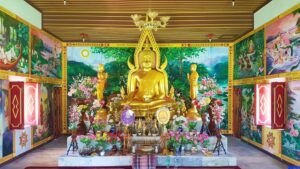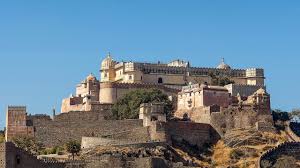India, the land of diverse cultures and spiritual heritage, is home to some of the most ancient and revered Buddhist monasteries in the world. The Buddhist Monasteries in India not only serve as centers of religious learning and meditation but also offer visitors a glimpse into the rich history and art of Buddhism. Whether you are a spiritual seeker, history enthusiast, or traveler, visiting these monasteries promises a deeply enriching experience. Here’s a list of the top 10 Buddhist monasteries in India that you must visit.
1. Tawang Monastery, Arunachal Pradesh
Located in the northeastern state of Arunachal Pradesh, Tawang Monastery is the largest Buddhist monastery in India and the second largest in the world after the Potala Palace in Lhasa. Perched at an altitude of 10,000 feet, this 400-year-old monastery belongs to the Gelugpa sect of Tibetan Buddhism. The monastery’s stunning architecture, vibrant prayer halls, and breathtaking views of the Himalayan ranges make it a must-visit for anyone interested in Buddhist culture.
2. Rumtek Monastery, Sikkim
Rumtek Monastery, also known as the Dharmachakra Centre, is one of the most important seats of the Kagyu lineage of Tibetan Buddhism. Situated near Gangtok, Sikkim, it was established in the 1960s after the 16th Karmapa fled Tibet. The monastery features exquisite murals, a huge golden stupa, and a peaceful environment perfect for meditation and spiritual learning. It is a key highlight among Buddhist Monasteries in India.
3. Hemis Monastery, Ladakh
Hemis Monastery is the largest and wealthiest monastery in Ladakh, known for its annual Hemis festival that attracts thousands of tourists and devotees. Founded in the 17th century, this Drukpa Lineage monastery is famous for its collection of ancient relics, thangka paintings, and its role in preserving Ladakhi culture and Buddhist traditions. The monastery’s scenic location in the Indus valley adds to its allure.
4. Tibetan Monastery, Dharamshala
Dharamshala in Himachal Pradesh is famously known as the home of the Dalai Lama and the Tibetan government-in-exile. The Tibetan Monastery, also called Namgyal Monastery, is an important center of Tibetan Buddhism where monks study and practice rituals. The monastery is surrounded by lush greenery and the majestic Dhauladhar mountains, offering a serene environment for visitors.
5. Thiksey Monastery, Ladakh
Often compared to the Potala Palace in Lhasa for its architectural grandeur, Thiksey Monastery sits on a hilltop overlooking the Indus River. It belongs to the Gelug sect of Buddhism and houses a 15-meter tall statue of Maitreya Buddha—the largest in Ladakh. The monastery complex includes numerous stupas, prayer halls, and monks’ quarters, making it a fascinating place to explore.
6. Tibetan Buddhist Monastery, Sarnath
Sarnath, near Varanasi in Uttar Pradesh, is one of the holiest Buddhist pilgrimage sites where Lord Buddha gave his first sermon after attaining enlightenment. The Tibetan Buddhist Monastery here is part of the Mulagandhakuti Vihara complex, featuring beautiful murals depicting the life of Buddha. This monastery is a peaceful retreat and an essential stop for anyone exploring Buddhist Monasteries in India.
7. Zang Dhok Palri Phodang, Sikkim
Located in Pelling, Sikkim, Zang Dhok Palri Phodang is a relatively new monastery but holds great religious significance. It houses rare Buddhist scriptures and texts brought from Tibet during the Chinese invasion. The monastery’s beautiful architecture combined with the panoramic views of the Kanchenjunga mountain makes it a spiritual and scenic destination.
8. Namdroling Monastery, Karnataka
Also known as the Golden Temple, Namdroling Monastery is the largest teaching center of the Nyingma lineage of Tibetan Buddhism in the world. Located in Bylakuppe, Karnataka, it was established in the 1960s by Tibetan refugees. The monastery features stunning golden statues, colorful murals, and a large prayer hall, drawing visitors from all over the globe.
9. Enchey Monastery, Gangtok
Enchey Monastery is an ancient Buddhist monastery situated in Gangtok, Sikkim. It belongs to the Nyingma order of Vajrayana Buddhism and dates back to the early 19th century. Known for its peaceful ambiance and annual festivals, the monastery is surrounded by thick forests and offers panoramic views of the surrounding hills.
10. Drepung Monastery, Karnataka
Drepung Monastery in Karnataka is another important seat of Tibetan Buddhism in exile. It was originally founded near Lhasa in Tibet and re-established in India after the Tibetan diaspora. The monastery complex is vast, housing several temples, prayer halls, and monks’ quarters, making it a significant religious and cultural hub.
Why Visit Buddhist Monasteries in India?
India’s Buddhist monasteries are not just religious centers but also living museums of art, architecture, and culture. Each monastery tells a story of centuries-old traditions, spiritual teachings, and the resilient history of Buddhism in the region. Visiting these monasteries allows you to witness ancient rituals, interact with monks, and absorb the serene atmosphere conducive to meditation and reflection.
These monasteries are also set in some of the most breathtaking landscapes of India—from the rugged Himalayas of Ladakh and Arunachal Pradesh to the lush hills of Sikkim and Karnataka. The combination of spirituality, history, and natural beauty makes the Buddhist Monasteries in India a unique and unforgettable travel experience.
Conclusion
Exploring the Buddhist Monasteries in India is a journey through time and spirituality. Whether you seek peace, cultural enrichment, or adventure, these monasteries offer something for everyone. From the grand monasteries of Ladakh and Arunachal Pradesh to the tranquil centers in Sikkim and Karnataka, each site reflects the profound legacy of Buddhism in India. Make sure to add these top 10 Buddhist monasteries to your travel itinerary and experience the spiritual heart of India.





